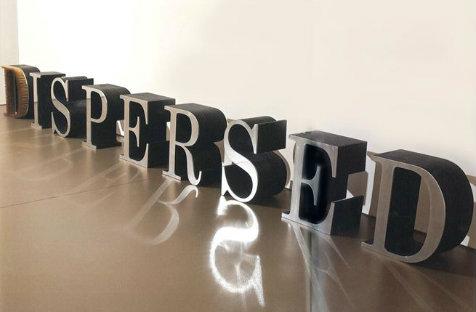It’s hard to believe a flower as unassumingly delicate as the poppy is steeped in such a turbulent history. Since 1920, the poppy has been used as a worldwide symbol of remembrance for fallen soldiers. It is also harvested for opium – a potent narcotic and key ingredient in many pharmaceuticals. Known for its sedative and hallucinogenic effects, opium has been the cause of illegal trade, conflict and debilitating addiction for centuries. It is this sinister side of the poppy that contemporary Indigenous artist Fiona Foley investigates in Obsession.
Part of the Ten Days on the Island visual arts program, Foley’s Queensland specific exhibition looks at the effects of opium addiction on Indigenous people, particularly during the late 19th Century. Comprised of three connected works – a series of text-based paintings, a video and a sculptural piece – Obsession sheds a sliver of light on the tragic outcomes of decisions made with prejudice.
A key work in Obsession, 1897 Aboriginals Protection and Restriction of the Sale of Opium Act (2006) brings our attention to a document of the same name issued by the Queensland Parliament. Presented as simple hand-painted text on a deep red background, the work stands as a historical marker for a devastating legislation that removed basic rights for many Indigenous people and included the removal of children. Several other similar paintings serve as reminders of addiction and display phrases like ‘Opium dregs’ and ‘Opium trade’.
As writer Rosalind Kidd (The Way We Civilise) elaborates further in Foley’s video Bliss (2006), narcotic dependency was used as a way to make employment seem more lucrative to Indigenous workers. In this work, panoramic fields of Tasmanian poppies sway in the breeze while Kidd’s text details aspects of the devastating 1897 legislation. Informative to a degree, I couldn’t help but want more detail from these works, to feel more deeply and understand more than what the snippets of text were offering.
Tucked into a corner is DISPERSED (2008). Glossy knee high letters spell out DISPERSED – a direct reference to 19th century police assignments to ‘disperse’ gatherings of Aboriginals (an order which connects to known massacres of Aboriginal people at the time). Ominously, the D is covered in sharp, silver-tipped bullets that subtly twinkle in the low, moody light.
Overall, Obsession is a scholarly collection of work clearly responding to a large body of research. Without prior knowledge of the events underpinning Obsession, the significance of the work may be lost on some. Discussing DISPERSED for the National Gallery of Australia, Bruce McLean states, ‘For the majority of people who know little about the racial relationships of early Australia, the work is somewhat curious’. Rather than describe the historical events in full, Obsession is like a series of dot points, a collection of understated triggers to steer the viewer towards their own search of history. This made the work feel somewhat clinical in style, which may or may not have been intended.
Obsession
Fiona Foley
CAST Gallery, Hobart
15 March – 14 April





